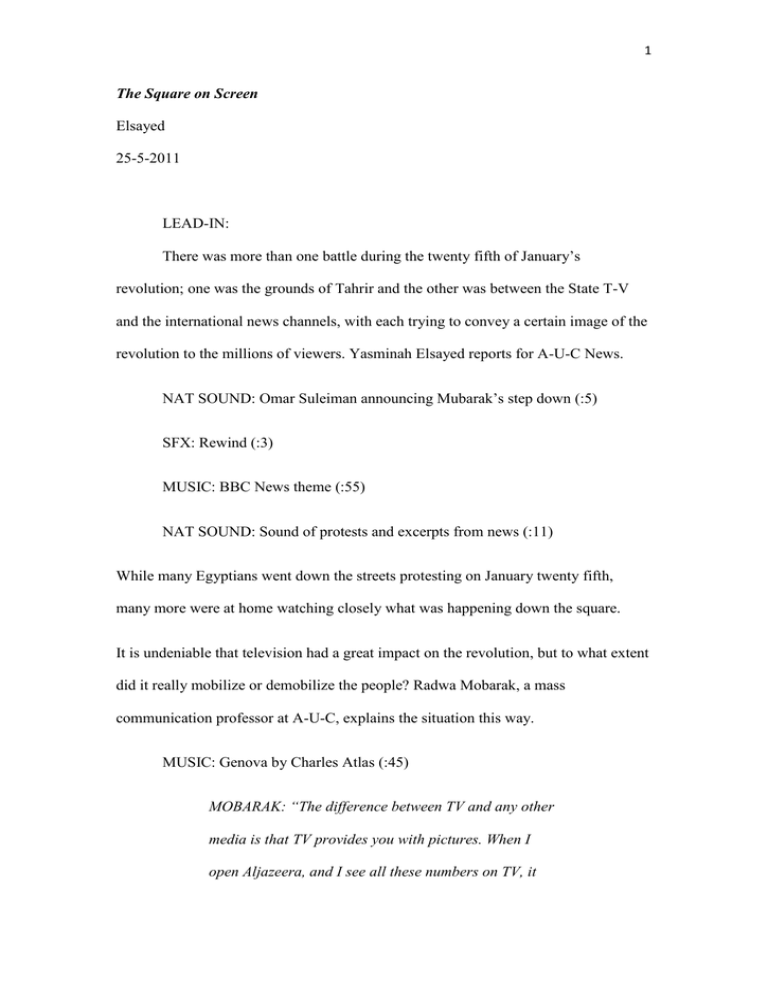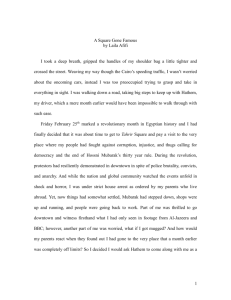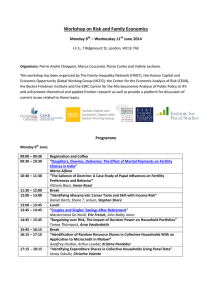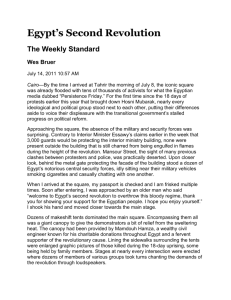The Square on Screen Elsayed 25-5-2011
advertisement

1 The Square on Screen Elsayed 25-5-2011 LEAD-IN: There was more than one battle during the twenty fifth of January’s revolution; one was the grounds of Tahrir and the other was between the State T-V and the international news channels, with each trying to convey a certain image of the revolution to the millions of viewers. Yasminah Elsayed reports for A-U-C News. NAT SOUND: Omar Suleiman announcing Mubarak’s step down (:5) SFX: Rewind (:3) MUSIC: BBC News theme (:55) NAT SOUND: Sound of protests and excerpts from news (:11) While many Egyptians went down the streets protesting on January twenty fifth, many more were at home watching closely what was happening down the square. It is undeniable that television had a great impact on the revolution, but to what extent did it really mobilize or demobilize the people? Radwa Mobarak, a mass communication professor at A-U-C, explains the situation this way. MUSIC: Genova by Charles Atlas (:45) MOBARAK: “The difference between TV and any other media is that TV provides you with pictures. When I open Aljazeera, and I see all these numbers on TV, it 2 will encourage me to go, because I know that this is not a group, that this is not for example a specific party; this is a popular thing.”(:15) Mobarak explains further MOBARAK: “How many people in Egypt have the internet? How many people are on Facebook? How many people are on Twitter? Not too many. But the TV, how many people does the TV reach in Egypt? This is the scale. Yes, we can for example take a video of what’s happening in Tahrir and Twitter it or Facebook it. But, when the TV channels takes this video from Twitter or Facebook and put it in its new bulletin then it makes all the difference”(:27) SHOEIR: “I should probably tell you what happened; on the twenty fifth of January I was watching TV and you know it just seemed like a couple of hundred people down there and I thought why is everybody making a bid deal out of it, it’s just a protest and you know the Interiors Ministry and State Security are going to clear it up literally in about a couple of hours.” (:15) Mirette shoeir is an A-U-C student who was at home when the revolution broke out. After watching the events closely on T-V, Shoeir decided to become more than just a spectator. 3 SHOEIR: “As I continued watching and it began going into the small hours in the morning;, at two o’clock, four o’clock, I noticed something very strange; people weren’t going home and they were chasing the police out of Tahrir Square and that’s when I started to realize that something serious was going on. On the twenty eighth, it really looked like a war zone down there and you really realized that this is a revolution happening. And yeah, I felt that we had to do something about it; we had to join in.” (:45) The T-V’s impact did not only reach out to those who were staying at home but, it was down there on the square as well. SHOEIR: “There was this huge banner. I don’t know how long. And it was saying a special thanks to Aljazeera, BBC Arabic and Al-Hurra and all the news channels who were broadcasting the truth and shame on state media. And it was right in the middle of Tahrir Square. So, I think that says a lot to go to the expense of printing that out and hanging it up.”(:10) Along with being a professor at A-U-C, Mobarak worked for State T-V and had firsthand experience witnessing how State TV handled the situation during the revolution. MOBARAK: “State television is part of the regime; no matter what we say, no matter what we do. This is what 4 we call State television. By State we don’t mean Egyptians; we mean the regime in power.” (:13) Mobarak continues. MOBARAK: “I remember on Wednesday, the day of Mawke’et El Gamal, What happened is that we had one of the reporters over there in Tahrir square, not only one reporter; there were three reporters on the scene with three different cameras. What happened is that they were reporting on the scene when Anas Al-Fiki called the Head of the News Sector, Abdel-latif ElManawy, and told him to get back all the cameras in Tahrir square. This order came when Mawke’et El Gamal started.” (:30) NAT SOUND: CNN broadcast of The Battle of the Camel (:10) MOBARAK: “I know people, reporters, who were standing with the army between the protestors and between the thugs. And the cameras caught things on tape and all of these tapes were taken and the cameras were returned and the reporters were returned and what was there was a beautiful view of the Nile. This is what was on air.” (:23) MUSIC: Nutcracker by Tchaikovsky (:6) 5 On any other occasion perhaps the scene of the Nile would have been a good idea, but that time it was just … well. SHOEIR: “It gave an image of general peace around Cairo. And you know empty streets in itself are already a clue that something serious is going on, when the 6th of October Bridge has no cars on it.” (:10) SFX: Birds chirping (:3) MOBARAK: “It provoked people. Even the people working at TV were provoked by this scene, by this shot of the Nile. They were demanding, where are the cameras in Tahrir?” (:14) MUSIC: Pink Panther by Henry Mancini (:15) Good question! So, where were the cameras again? Were they perhaps stolen? Or may be broken? Well, you’ll be surprised. MOBARAK: “There were cameras on the Nile definitely, there were cameras in Tahrir, there were cameras in front of TV, there were cameras that weren’t let out because some people decided not to take the cameras out fearing that the cameras would not return back safe and they will have to pay for them” (0:21) MUSIC: Pink Panther by Henry Mancini (:5) 6 A simple question that probably crossed some people’s minds, during the revolution was; whether the Egyptian media was broadcasting the truth or not? And if not, then who was behind it? MOBARAK: “Who was basically on top of this hierarchy in the television building? The minister, Anas El-Fiki was one of the people of the regime. At a certain point in time when people really did not know what to believe exactly; the internet was cut, people could not reach the people in Tahrir square, what was he doing? He was terrorizing people.” (:25) The terror campaign was carried out by some State T-V reporters and anchors, who faked phone calls spreading false rumors that the protestors were all foreign agents. NAT SOUND: Tamer from Ghamra crying on State TV (:8) MOBARAK: “The very same day of Mawke’et ElGamal at night, you can see one of the most prominent news anchors on channel one, who is now presenting Masr Enaharda; Reham Ibrahim. She was on air saying ‘korat mn allahab! Korat mn allahab!’ She was saying that there were fire balls falling on the protestors, and she was calling on the protestors to go back home and I think this is a campaign.” (0:31) 7 One of the most controversial coverage of the revolution was that of Al-Jazeera. Some people believed it to be biased towards the protestors, while others believed it to be objective. MUSIC: Al-Jazeera theme (:4) MOBARAK: “What I liked about the coverage of AlJazeera is the live coverage. They used to just put the camera there and open it for people to see what’s going on in Tahrir square but, I thought that their coverage was somehow biased when it came to specific things.”(:15) SHOEIR: “No! No, I think that Al-Jazeera always gets the short end of the stick over any event that happens. I just think they’re very focused on what’s happening so people say that they’re biased, they’re not. They’re just covering it from a very close perspective and if you’re right there and people are getting shot and you have that on camera and you air it, people might say you’re biased, but you’re just telling the truth; you’re just showing what happened.”(:35) During the revolution several journalists and media people faced hard times, Professor Walid Kazziha, a prominent political science professor at A-U-C, explains what happened. 8 KAZZIHA: “This period was a very tough period for journalists and media people. Several journalists were beaten up; the ones of Al-Arabiya, the ones of AlJazeera. Associated Press and Al-Jazeerah offices were attacked by mainly security people.” (:27) NAT SOUND: Journalist being attacked (:11) KAZZIHA: “This was deliberate attack; their cameras were taken away from them, the furniture was stolen. During the events journalists were targeted.” (:11) SFX: Old projector MUSIC: Sawt Al-Watan by Um Kalthoum In nineteen fifty-two, Um Kalthoum sang Sawt Al-Watan after the success of the revolution with the overthrowing of King Farouk. On July twenty third of the same year, the free officers took control of the State media building to broadcast the news of the coup’s success on the radio. Walid Kazziha narrates his memories of the event. KAZZIHA: “I remember that Anwar Sadat gave the first communiqué; Al-Bayan Al-Awal.” (:10) NAT SOUND: Anwar Sadat’s first communiqué (:5) “By 1952, political parties became ineffective in Egypt like we felt probably in 2010, 2011. That we need to change, and that we need to change desperately. I think the same kind of air and atmosphere emerged at that time.” (:30) Surprisingly, when the coup succeeded, professor Kazziha was not very happy. 9 “When Nasser’s coup took place, I did not have a good impression towards it because, it was a military coup. In my memory military coups were not the right ways of change. It was associated with repressive measure of the army and elimination of freedom of expression.” (:27) But professor Kazziha’s initial impression soon changed. KAZZIHA: “I think things began to change in my mind when Nasser raised the idea of Arab unity. When the Egyptian coup was transformed to declared Egypt as an Arab country willing to share with the other Arab countries their destiny.” (:23) The events of the twenty third of July might not have been greatly influenced by the media as much as the case was on January twenty fifth; however, the media’s role grew more as the revolution developed. KAZZIHA: “The revolution was aware of the power of the media and that if you want to have an impact outside your own borders, you don’t only take trips outside and meet other leaders, but you also work on the media to reach the people outside.” (:27) As for the media channels that were present at that time KAZZIHA: “They had Cairo Radio, they had Sawt Al-Arab with very powerful broadcast, technically very powerful; they could reach all parts of the Arab world. Cairo used to broadcast to African countries in their own language and there was also broadcasting to Israel in Hebrew.” (:30) 10 NATSOUND: Radio Cairo broadcasting in Hebrew (:10) KAZZIHA: “I think after the tri-partied aggression on Egypt in nineteen fifty six, the Egyptian media went in full swing to the outside world and it was quite effective. But, that time TV wasn’t a major instrument of the media in third world countries. “(:26) On the twenty fifth of January, Egypt’s history took a different turn. It was the people who steered the wheel; it was the people who used the different media channels to decide their destiny. KAZZIHA: “I think I’ve learnt that time for change is something, something that you feel. And it lasts for a long time until someone comes and gives a push to the existing political order and then afterwards it’s everyone’s guess; you could go backward or you could go forward.” (:26) MUSIC: Ehlam Ma’aya by Hamza Namira (:57) Translation: “Dream with me, Of a tomorrow that’s coming, And if it doesn’t come, We’ll bring it ourselves. We’ll stride upon this path, Our many footsteps will lead us to our dream.” Special thanks to: Professor Walid Kazzhia, Professor Radwa Mobarak and Mirette Shoeir. CNN News and Radio Cairo. Music: BBC News theme, Aljazeera News theme, Pink Panther 11 by Henry Mancini, Genova by Charles Atlas, The Nutcracker by Tchaikovsky, Sawt AlWatan by Um Kalthoum, and Ehlam Ma’aya by Hamza Namira




